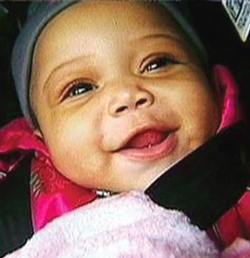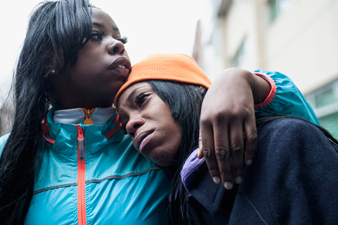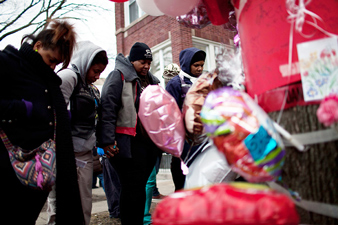By Charlene Muhammad CHARLENEM
Shooting of baby brings focus on spiraling violence inside Black America

Is it finally enough?
While some wonder if, and others pray that, the recent shooting death of six-month-old Jonylah Watkins in Chicago brings enough shock, sadness, pain and outrage to reverse violent trends in inner cities, anti-violence experts and advocates say change nor a healing will come until America confronts and corrects the causes of such violence head on.
It’s almost inconceivable that a gunman could walk up to the van where Jonylah’s father was changing her diaper in their Woodlawn neighborhood, and open fire. But the act indicates just how far man has fallen, they say. The child’s funeral was set for March 19 at Final Call presstime.
“It (violence) eats away at our humanity,” said Dr. Joy DeGruy, researcher, educator, and author of “Post-Traumatic Slave Syndrome: America’s Legacy of Enduring Injury and Healing.”

“One of the overall responses is it injures people. It makes children fearful. It creates hopelessness. And the flip side of it is it begins to normalize. People begin to normalize the violence as something that’s acceptable and that they have to reconcile themselves to,” Dr. DeGruy told The Final Call.
The development as human beings is going the wrong way, but that stems from an obsession with amassing material things to satisfy cravings or needs for acceptance or beliefs about success, she said.
But people should be moving towards a level of higher consciousness, she continued. “I don’t mean that in some kind of non-tangible, esoteric ways. I’m talking about basically arising from what is very base and very animal to begin to start looking at ourselves as whole beings–mentally, emotionally, spiritually,” Dr. DeGruy said.
Student Minister Ava Muhammad, national spokesperson for the Honorable Minister Louis Farrakhan and the Nation of Islam, immediately reflected on the stern warning he gave during the tenth installment of his 52-week lecture series, “The Time and What Must Be Done.”
She also considered his guidance when reflecting on solutions to and finding a way to heal from the psychological and social impact of extreme violence plaguing Black America.
Min. Farrakhan “spoke to Caucasians. He spoke to Black people. He spoke to all of us globally and to us in particular, he said, ‘I am warning you to get your blood off my hands.’ Because he does not want to be held accountable by Allah and his Christ for our blood,” Minister Ava said.
“We are actually undergoing chastisement. We simply could not persist in our rejection of Allah’s love and mercy, given to us through his Messenger and through their anointed, Minister Farrakhan,” she continued.
People’s rejection of Minister Farrakhan’s guidance has led to a splitting asunder of generations in the Black community, she said. Murder has been the result of alienation of parents from their offspring, she continued.
“They’re being killed by police and they’re being killed by one another, and this is because, as Master Fard Muhammad labeled us properly, he called the Caucasian a thief and the Black man a savage,” Minister Ava Muhammad said.
For the past 18 years, Student Minister Tony Muhammad, the Western Region Representative of Min. Farrakhan and the Nation of Islam has worked to help curb gang violence and help bring healing to impacted families and communities.
A knowledge of self is missing for those committing these extreme acts of violence, he said.
“Just when we think we’ve hit rock bottom, we go lower,” said Ava Muhammad continued, referring to the murder of Hadiya Pendleton, killed not far from the president’s Chicago home a week after performing at Barack Obama’s inauguration, and several other indifferent, indiscriminate shootings preceding Jonylah Watkins. She was also referring to the March 9 police shooting of 16-year-old Kimani Gray in Brooklyn, N.Y.
Because youth overall are not being taught a sense of responsibility, they fear no consequences, Tony Muhammad said. But the problem has a greater root, he added.
“Our 400 year old enemy, as a result of a void in knowledge of God and who one is, has socially engineered us into a self-destructive creature who doesn’t mind killing others. The enemy programs people for murder,” he said.
According to Tony Muhammad, the spiritual consequence of extreme violence witnessed is great because without correction, it causes shooters to become worse and enables them to impose the idea of murder on those under their influence.

Victims’ families sink into the depths of depression, to the point of apathy, when it comes to Black on Black violence, not White on Black, he said.
“We don’t fight against it, when Black people kill us. But when White people kill us, we’ll march all day … Now everybody’s worried. We’re a community that’s allowed our minds to put us in a spiritual and mental prison,” he said.
The healing process must include helping to move Black communities out of the depression which stems from violence, and ending the cycle of self-fulfilling prophesies based on what others have said Blacks are and will become, Tony Muhammad said.
“All we have to do is confront it. People won’t even sit on their front porch, walk in their front yard. That’s why the Minister has us in the streets. We’re disagreeing that this is going to keep going on, that we will keep killing each other. I don’t agree with it because my leader doesn’t agree with it … . We can stop this,” Tony Muhammad declared.
Crucial elements in stopping extreme violence include understanding primarily Black male violence is caused by economic castration of the Black male, miseducation, serious mental illness and broken homes, said Dr. Umar Abdullah Johnson, author and nationally certified school psychologist.
“These people out here killing are also victims,” he said. “You don’t get to victimize unless you’ve been victimized. … Violence as Dr. (Martin Luther) King said is nothing more than the voice of the voiceless.”
Black people all across America are reaching a psychological breaking point, he added.
Some would say, so are the youth.
But there are many young people across the country pushing back against violence, according to Kim McGill of the Youth Justice Coalition, a Los Angeles-based youth advocacy organization.
Black and Brown youth are disproportionately the victims of the violence that has crept into so many urban neighborhoods. And according to the Youth Justice Coalition, homicide is the leading cause of death for Black youth, the second leading cause among Latino youth and third leading cause among Native youth ages 10 to 24.
Homicide rates for Black males is the highest in the nation, 51.5 for every 100,000 and since 2008, more than 530 youth have been killed in Chicago with an astonishing 80 percent of those murders happening in 22 Black or Latino communities on the cities South, Southwest and West sides, according to the group.
How youth of color are treated when violence strikes compared to White communities must be at the forefront of any analysis of violence, Ms. McGill argued.
“You can’t talk about Chicago without talking about Sandy Hook because I think it points out when White youth die in our nation it’s seen as a tragic loss and when young people of color die in our nation it’s just seen as another day,” Ms. McGill stated.
The federal government, President Barack Obama, local officials and law enforcement rushed put more police in schools, yet in communities of color, that tactic actually pushes youth away from schools, she continued.
She adamantly rejects the notion of labeling the problem as youth violence because the majority of the time, people doing the shooting are not young people.
But the high levels of violence persist in America because it doesn’t value Black and Brown youth, she charged. “If we don’t look at the conditions that lead to violence in our communities: Poverty, unemployment, lack of educational opportunities, and a real lack of racial justice, then we’ll never address violence in the streets. And if we don’t look at police violence, we’ll never address the underlying conflicts that often times lead people not to trust or look at community solving approaches,” she told The Final Call.
The Youth Justice Coalition offers these solutions to begin addressing the issue of urban youth violence: saturate the community with jobs, implement peace building initiatives for conflict resolution, create school and community education programs to reduce America’s addiction to guns, address Post Traumatic Stress Disorder for people that have experienced extreme violence and increase gun buyback programs.
“Everybody’s asking young people what they need when these acts occur, but they’re never asked what they feel would stop the violence. Young people and secondary parents are the real experts and consistently this is how they respond when we ask them: Where’s the jobs, the youth centers that stay open from 3 p.m. to midnight, the peace builders and OGs that we trust and can listen to? These solutions are never invested in,” Ms. McGill explained.
Ansar Stan Muhammad, co-founder of the H.E.L.P.E.R. Foundation, formerly Venice 2000, a gang intervention and prevention advocacy organization, agrees. His organization has worked for decades throughout California to help provide those types of resources.
“Whenever people and our communities are deprived of bare necessities, of a natural existence, which is food, clothing, and shelter, then you create an environment that’s going to be conducive to negativity and violence,” he said.
There is also the problem of gentrification and the hidden hand of those who are hired to take control of Black and Brown communities, the activist insisted.
A solution is to create resources to help people get back on their feet and change their conditions, he said.
So fed up with the senseless loss of life through violence, he challenges anyone with the same sentiment to reach out to him at 310-925-2071 to dialogue on where to begin forging a solution in their communities.
“Start with the proper attitude, understanding that this is a crisis, number one … We’re at war but not without each other … The key question is who is the beneficiary of the violence. It’s not us,” he said. -FinalCall.com












